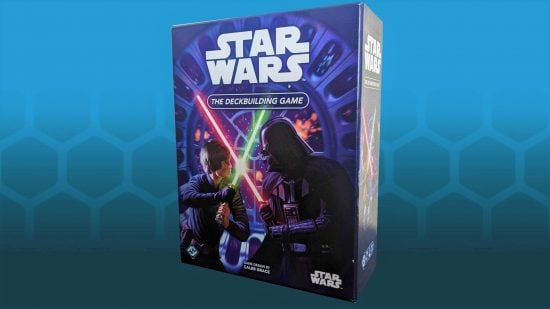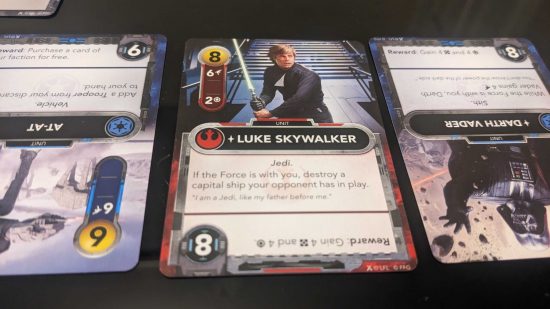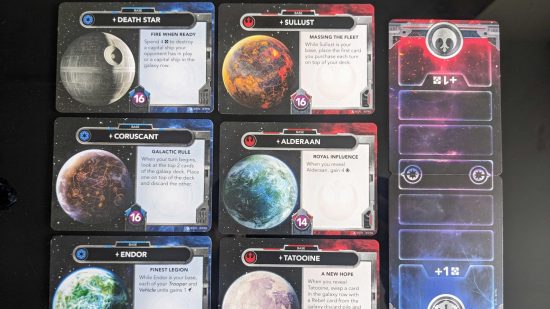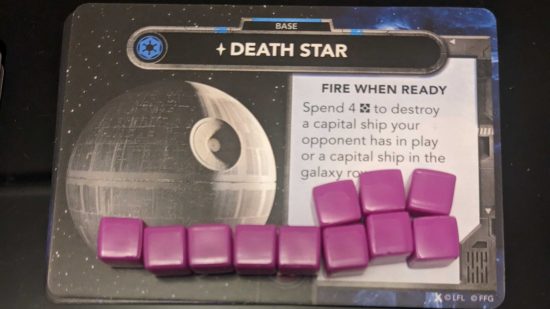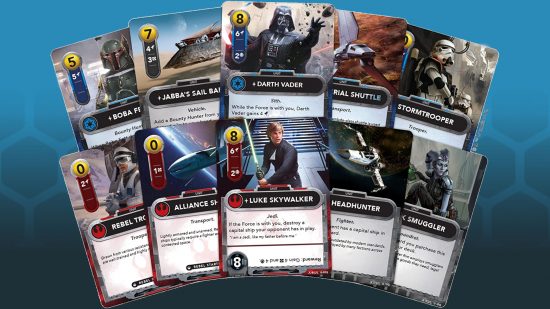Our Verdict
A thematic and approachable deck-builder, the Star Wars: Deckbuilding Game gets you plenty of laser gun bang for your buck. It's let down by some of its components, and the more swing-y elements may put some players off, but there's still plenty to love in the little box.
When I think of the Star Wars franchise, ‘compact’ isn’t the first word that comes to mind. It’s taken 12 movies – plus a small army of series, videogames, and Star Wars comics – to build the galaxy far, far away. And don’t even get us started on the number of Star Wars board games there are to choose from. At first glance, Star Wars: The Deckbuilding Game looks like a tiny box in a flooded market.
But Fantasy Flight Games is no stranger to publishing great licensed board games, and it’s got some of the best card games there are under its hat. The Star Wars Deckbuilding Game is a strong deck-building game that’s highly thematic, highly approachable, and highly affordable. Some elements may stray a little further to the Dark Side and sully a game or two, but overall, it’s a Force to be reckoned with.
What is the Star Wars Deckbuilding Game?
Star Wars: The Deckbuilding Game is a two-player board game where the Rebels go head-to-head with the Empire. Each faction is racing to destroy a certain number of enemy bases, and doing so means they need to build the strongest deck of cards possible.
As in many of the best deck-building games (looking at you, Dominion), both players begin with a relatively puny starter deck. This means you’ll need to play cards and generate resources to purchase stronger cards from Galaxy Row, a regularly-replenished line of random cards in the center of the table. You can only buy cards from Galaxy Row if they’re a neutral grey or they belong to your faction – you can also attack enemy cards, destroying them before your opponent can buy them and granting you a nice reward for doing so.
Speaking of attacking, you’ll be doing plenty of it in the Star Wars Deckbuilding Game. When players aren’t silencing enemies in Galaxy Row, they’ll be sending units and capital ships to attack the active enemy base. Get past defending capital ships and blow the base up, and you’ll claim it and get one step closer to victory. But beware – your opponent now gets to choose a fresh base which will likely come with a powerful new ability.
As well as generating spending money and amassing an armada, players have one final resource to contend with – the Force. Certain cards give you points in the Force when played, and others have abilities that only trigger if the Force ‘is with you’ on your end of the game’s Force tracker. This adds an additional push-and-pull element that could make or break your faction in certain circumstances.
Is the Star Wars Deckbuilding Game good or bad?
With highly approachable rules and a play time that clocks in well under an hour, Star Wars: The Deckbuilding Game is ideal for beginners. If you know a Star Wars lover who’s yet to explore the complexity of trading card games (or maybe just prefers easy card games in general), this could be a great gateway game.
It’s also a strong choice for lovers of faithful Star Wars adaptations. Fantasy Flight Games has nailed the theme here, designing decks that really represent the factions they depict. The Empire deck focuses on controlling the state of Galaxy Row while also buffing its wall of ships, vehicles, and troops. Meanwhile, the Rebel deck is the scrappy underdog who sneaks in to interrupt the Empire player’s hand and hit their bases from behind enemy lines.
Puzzling out what makes your deck tick offers plenty of intrigue, even for a more experienced card gamer. I was a particular fan of the base mechanic: each offers a different advantage when it’s played. This provides some tasty synergy in the good times and some well-needed flexibility if things aren’t going your way. The beginner version of the game is fairly limited when it comes to bases, but the Full Galaxy variant lets you stretch your TIE Fighter wings far further.
While the Star Wars Deckbuilding Game does offer multiple variants, it doesn’t provide the flexibility of larger, more crunchy deck-builders. Agents of chaos who might want to mix and match a deck where Darth Vader and Luke Skywalker can fight together will need to look elsewhere. Star Wars: The Deckbuilding Game’s limitations make for an excellent theme, but the game’s replayability may also be limited.
That’s not all that’s amiss in the galaxy, either. Certain physical design elements grate like sand (they’re rough and irritating). Star Wars: The Deckbuilding game has wonderful card art, but the damage cubes included feel inefficient. It’s incredibly fiddly using a large number of them to track the state of your enemy base.
I also wasn’t a huge fan of the Force Tracker. The two decks feel well-balanced, but the Rebel player always starts the game with the Force maxed out to their side of the tracker (which has the added bonus of giving you a free resource at the start of your turn). This puts the Empire at an immediate disadvantage, forcing them to focus far more on chipping away at the Force to make use of it later on.
The Empire always takes the first turn, but given how valuable the Force can be, this doesn’t feel like a fair trade-off. The game’s Full Galaxy mode has bases to help swing things the Force more dramatically in your favor; however, in our beginner games, the Empire player often felt shut out of Force activities.
The random elements of the game can also cause frustration on occasion. If Galaxy Row doesn’t offer the cards you need to optimize your deck, the game can feel stunted. Your bases may be attacked before you see a single capital ship or Galaxy Row may become clogged with enemy cards that are too difficult to shift and replace with new ones. Part of the fun of deck-building in this game is adapting to your environment, but when your deck can only do so many things, you don’t always feel fully in control.
Selling for around $40 / £30, the Star Wars Deckbuilding Game has plenty to offer. The affordable price takes some of the sting out of limited replay options and disappointing component choices. What you’re left with is a highly thematic, visually appealing, well-balanced, and intriguing deck-builder. It might not keep the attention of crunch-lovers who want minimal random elements, but it’s a worthy addition to the galaxy of Star Wars board games out there.
